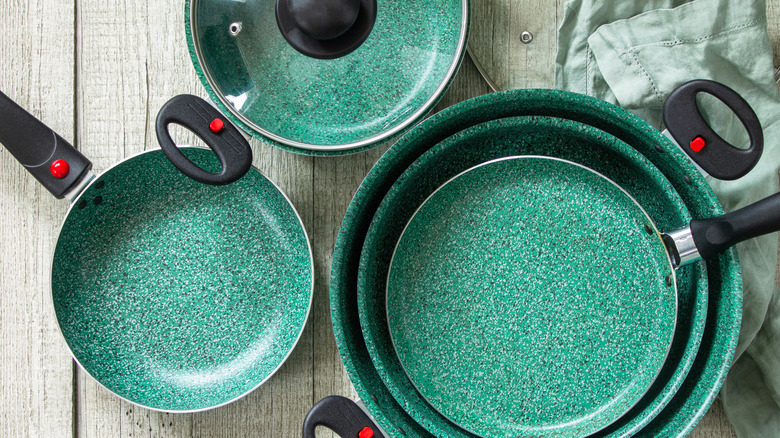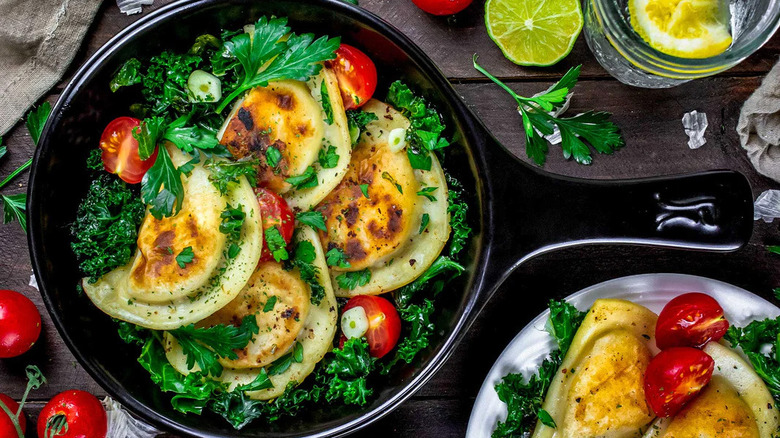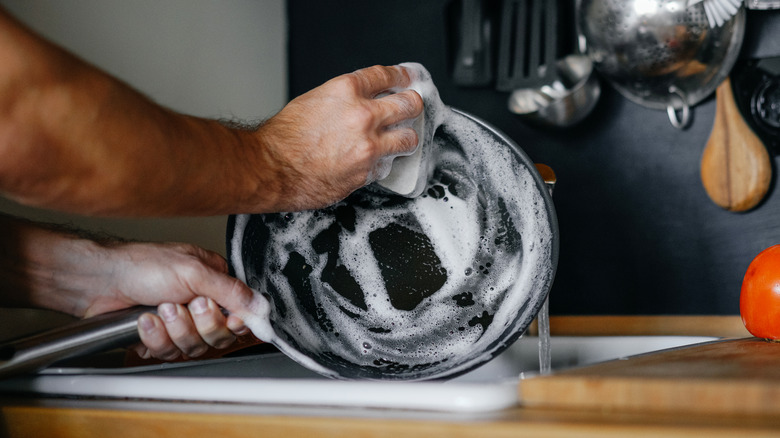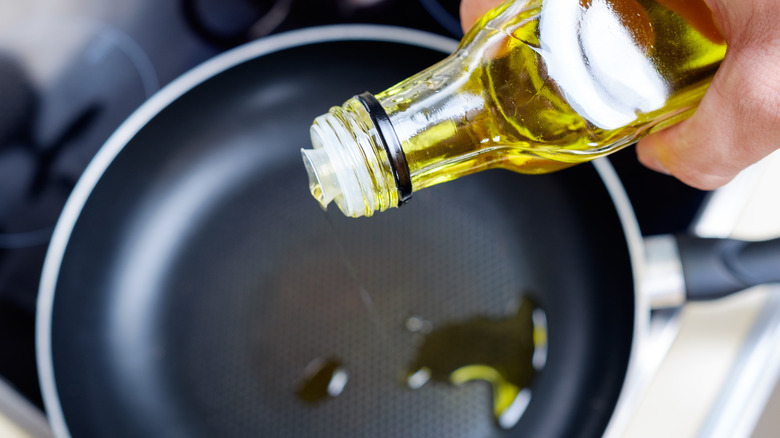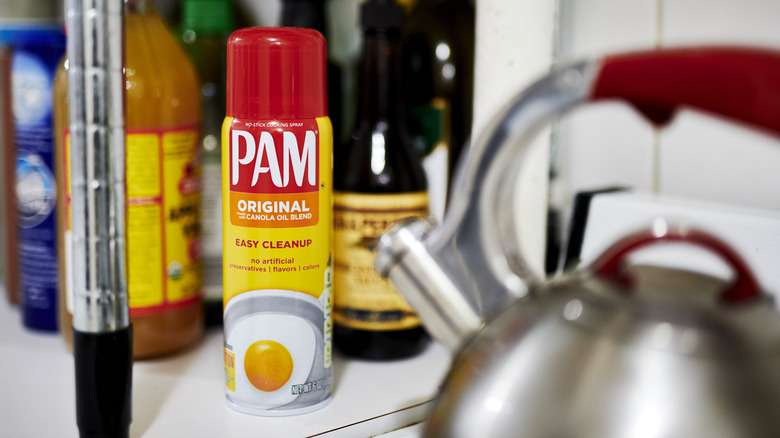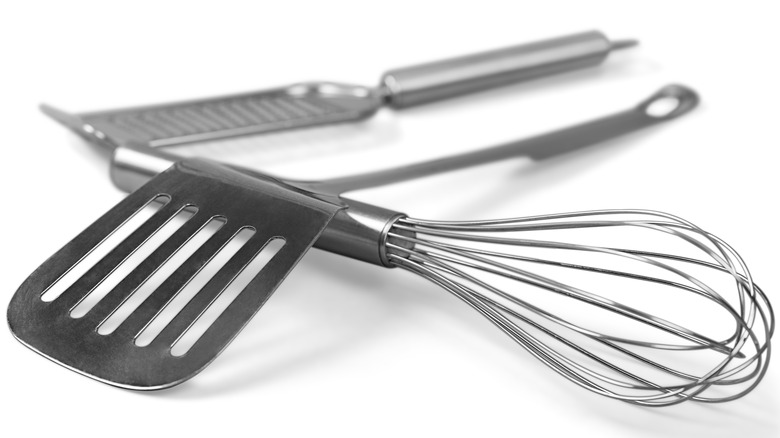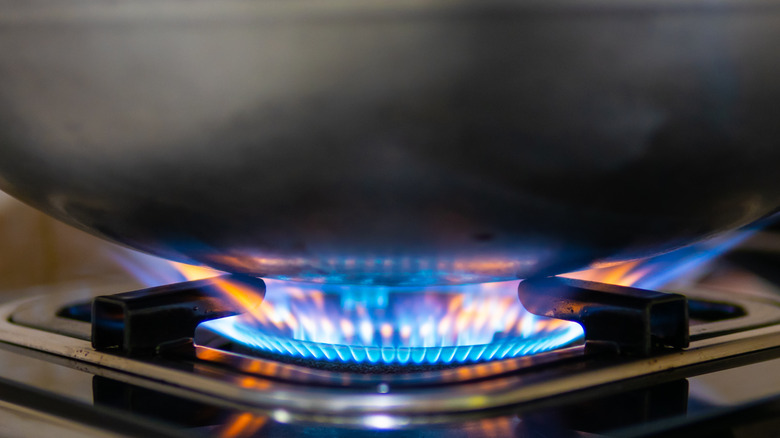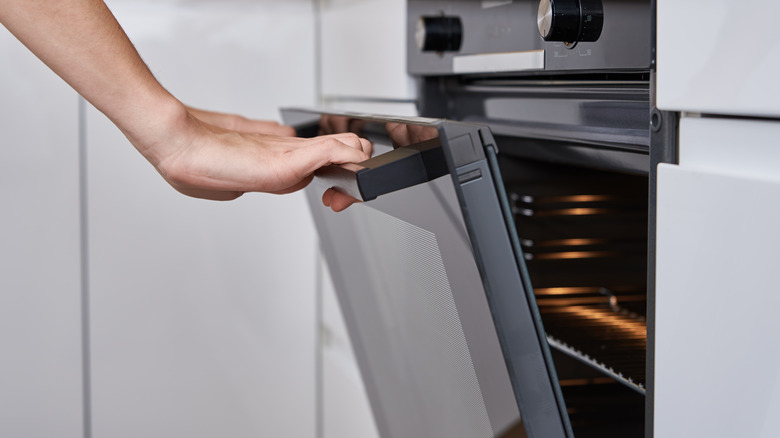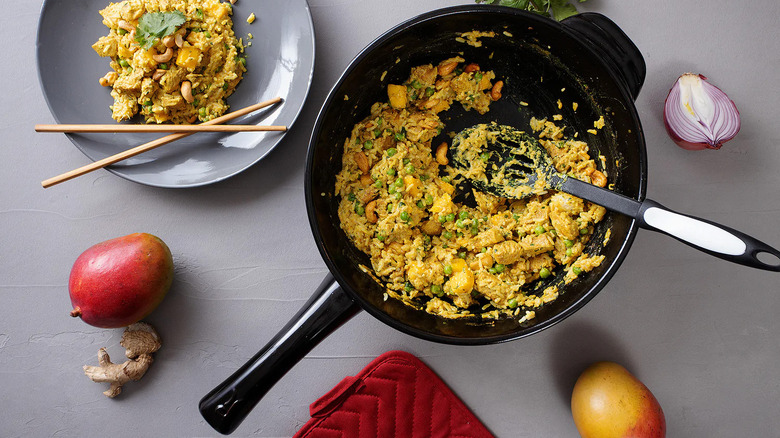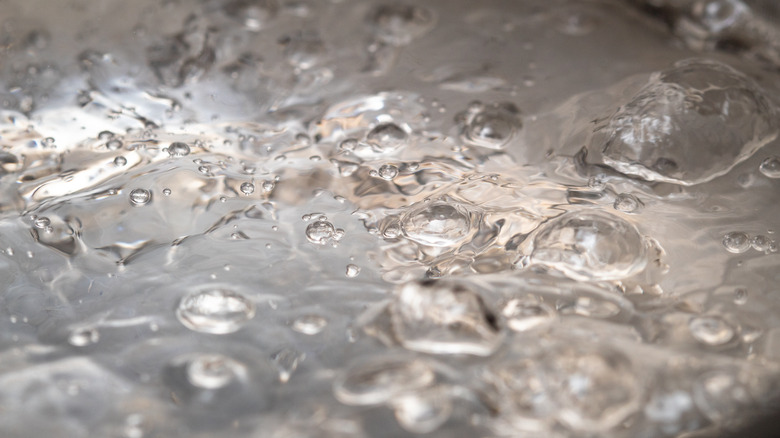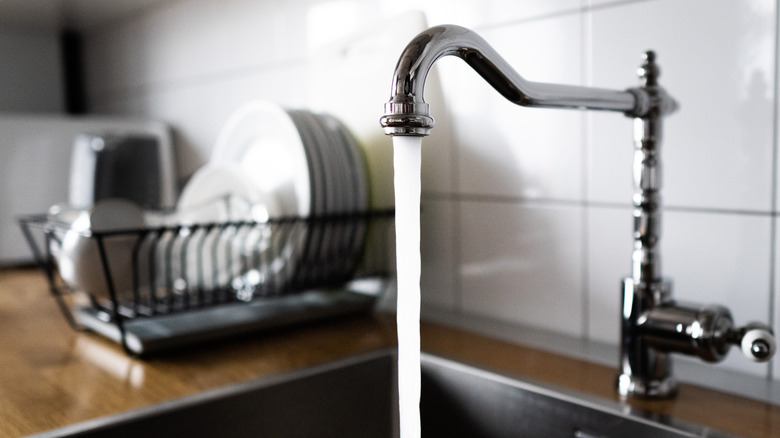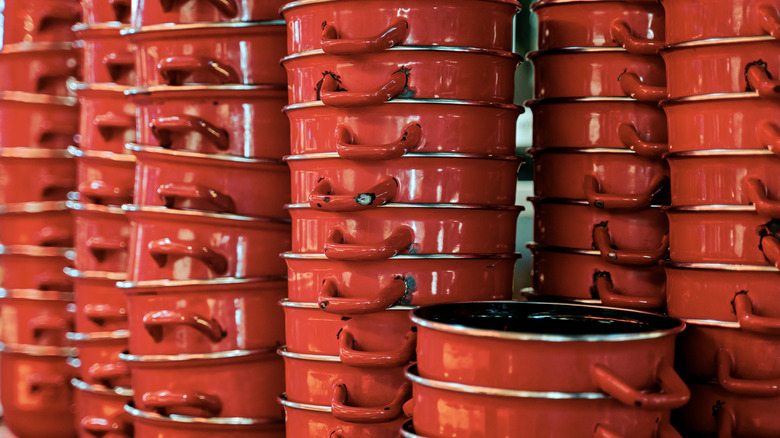11 Tips You Need When Cooking With A Ceramic Pan
If you're into quality cookware, you've probably heard that all the cool kids are buying ceramic non-stick pans. They're touted as being great at heat retention, easy to clean, and available in a wide range of colors. Some time ago, when Teflon-coated pans were all the rage, reports later revealed their tendency to produce toxic chemicals. As a result, manufacturers were forced to pursue an alternative non-stick option: ceramic cookware.
A common misconception is that ceramic cookware is 100% ceramic. And although they do exist, the types you're likely to come across are actually coated stainless steel, cast iron, or aluminum pans. The O.G. non-stick pan, Teflon, is coated with "PTFE" (shortened from an incredibly hard-to-pronounce word), while ceramic is coated with "sol-gel," a non-toxic substance that is composed of silica (sand) and other inorganic materials. Despite not being 100% ceramic, sol-gel gives a pan the appearance of one. The coating is also used because ceramic pans aren't naturally non-stick. As such, the typical life span of a quality one that's well-maintained still only lasts from three to five years.
Short life-span aside, even cast-iron and stainless steel purists are adding them to their cookware arsenal. They're also considered an essential tool every kitchen should have. With any shiny new toy, there are some recommended best practices to achieve desired results. That's why we decided to put together a list of necessary tips to use when cooking with your ceramic pan.
There are two types of ceramic pans
As mentioned, most cookware advertised as ceramic is actually sol-gel coated metal. While both are more than effective for cooking, each also has its own pros and cons. Pure ceramic pans, also known as earthenware, are made from thermally processed clay that's naturally occurring and rarely contains contaminants. Unlike ceramic non-stick cookware, which begins to break down after exceeding temperatures above 500 F, pure ceramic can impressively withstand up to 2,500 F. It also provides even heat distribution and produces steam better, which means it doesn't require as much fuel and energy.
Not only does clay feature many benefits, but, according to NPR, it's the oldest material used for cooking in all of history. "Healthier" is often associated with ceramic cookware, and while that's true, there are exceptions that can impact the foods you consume. For example, when it comes to pure ceramic cookware, there are glazed and unglazed. The glaze is used to add color and a finish to ceramic pieces. It gives them a more attractive contemporary look. Be that as it may, you should only purchase glazed cookware from trusted companies that include clear certifications, as cheaper brands may contain lead.
A mainstay of ancient culinary methods, unglazed ceramic cookware is less common today, mostly enjoyed by a niche following. With that said, when it comes to deciding which is the best cookware, you can either go the more affordable yet coated route, or the purer yet pricier one.
Always hand wash your ceramic pan
A common mistake people make when using nonstick pans is not cleaning them properly. Before using your fancy new ceramic cookware, you should first hand wash them with warm soapy water. A sponge or soft cloth is suggested because they remove the dirt along with dust particles commonly found on new products without damaging the coating. Now you're ready to fire it up. Ceramic pans have a tendency to warp and don't take well to sudden temperature changes. So after each use, wait until it cools down, then wash your pan to avoid leftover food build-up and brown stains.
Life can get busy, so you may want to save time by tossing your ceramic pan into the dishwasher, but before you do that, it's a bad idea to use a dishwasher to clean nonstick pans. Even though many pans are labeled as "dishwasher" safe, cleaning detergents can damage the sensitive coating and cause it to peel. Peeled bits of coating have the unfortunate potential of contaminating your food.
Another thing to keep in mind is that dishwashers are filled with a range of different cookware, forks, spoons, and knives, which can potentially fly loose of their container and scratch your pan's surface. A good hand wash will help your ceramic pan maintain its coating and have a longer-lasting life.
Add a little oil to season your pan
As an owner of various types of pans, you're probably familiar with the concept of seasoning. Not only does it make cookware surfaces non-stick, but it also contributes to their longevity. For particular types, it even infuses flavors from previous use into new recipes. When it comes to ceramic non-stick pans, the verdict's still out. Some brands don't suggest seasoning them, but it varies from manufacturer to manufacturer. If the pan you own happens to require seasoning, it's important that you grease it the right way.
The process is simple enough. Whether brand new or used, you should first hand wash and then thoroughly dry your pan. Next, coat the surface with a tablespoon of oil that has a high smoke point like vegetable, avocado, or canola. Because ceramic pans operate best under low to medium temperatures, use an oven or stovetop to slowly heat up the oil. Once the oil begins to smoke, it's time to remove it from the heat and let it cool down. Remember that ceramic pans don't react well to drastic temperature changes. After the pan cools to room temperature, you can wipe away excess oil with a paper towel or soft cloth.
Following these steps should reward you with a pan that's ready for some non-stick cooking. Every few months, depending on how much you use it, rinse and repeat to maintain your pans.
Cooking oil sprays have chemicals
As the name suggests, ceramic non-stick pans require less oil than stainless and cast-iron types. While there's nothing wrong with applying some lubricant, it's important to be mindful of the amount and kinds you use. This is especially true of cooking spray oils, which have a tendency to damage the non-stick coating. One reason why you shouldn't use them on your coated cookware is that it contains lecithin, a substance with a mixture of fats that resists heated surfaces. Many also consist of an anti-foaming agent like dimethyl silicon, or pressurized gasses like propane, and butane.
Basically, it gradually wears down the non-stick properties of the coating. Consistent use over time creates a buildup of film that becomes nearly impossible to remove. Then when you attempt to clean it, you can potentially cause further damage. Using a paper towel or soft kitchen cloth to apply minimal amounts of vegetable, canola, or olive oil is always recommended over cooking spray.
For pure ceramic pans, add a light layer of oil or fat before heating. In addition to the oil types that work with non-stick pans, avocado, coconut, and other oils, including butter and ghee, give pure ceramic pans a wider range.
Metal utensils will scratch the coating off
Whether scrambling a tasty egg or frying up delicious hash browns, sometimes your pan requires a good scraping. Before non-stick hit the cooking scene, metal spatulas, tongs, and spoons were perfectly suitable for durable surfaces like cast iron. But to enjoy the many benefits that ceramic non-stick pans offer, some rules must be followed. Aside from being mindful of oil use, you should never use metal utensils while cooking with non-stick surfaces. This may seem like a no-brainer, but making obvious mistakes is a normal part of being a home chef.
Metal utensils are solid and have sharp edges that can damage the delicate non-stick coating. With continued use, scratches on the surface will ruin your pan's ability to prevent food from sticking. Knives in particular should never touch the surface. If an ingredient requires cutting, it should be done on your board before it enters the pan. This is an area where cast iron and stainless steel have the advantage, but in no way should prevent you from whipping up something equally as tasty.
Scraping also chips away, leaving tiny specks of non-stick material that can creep into foods when you cook. According to a 2016 research article published in the Journal of Nanotechnology, sol-gel contains titanium dioxide nanoparticles, which are known to be toxic. Basically, those tiny specks may present health risks if consumed. That's why when cooking with a ceramic non-stick pan, silicon utensils are recommended.
High temperatures damage non-stick coating
As mentioned previously, low or medium heat is suggested when cooking with ceramic non-stick pans. Most can only manage temperatures up to 500 F. As you surpass that temperature, the non-stick coating will begin to burn and potentially emit toxic fumes. High heat also causes foods to stick due to a reaction called thermocapillary convection. This is explained in a 2021 study, published in Physics of Fluids, as focused heat making oil in the center of the pan move outward.
Dry heating should also be avoided at all costs. It's when you leave your pan sitting, exposed to an active stove top before adding oil or fat. Contact from excessive heat of any temperature will gradually degrade your pan's coating. Even if the pilot is in a low-temperature setting, it still can have a negative impact. As a rule of thumb, always make sure your pan is lubricated with oil or fat before cooking. After all, cookware preservation is the goal.
Other results of overexposure to high heat are cracks in the surface, warpage, and exterior discoloration, which, aside from being unappealing, reduces its longevity. This is more often experienced with lower-quality ceramic pans that aren't cladded (layered in sheets of metal). That's why, to ensure long-lasting cookware, you should always purchase the best non-stick pans your budget can afford, and, of course, follow these suggested care instructions.
Pure ceramic pans are oven-safe
While most ceramic non-stick pans are generally oven-safe, you should always make sure by checking out the manufacturer's recommendation. It'll let you know if you have the green light, as well as suggested temperature ranges. Even if it's cleared for oven use, one setting you should never use is broil. You'll definitely regret it. Before placing your pan inside, first make sure all parts are heatproof, in other words, made of metal or silicone. It goes without saying that plastic and wood material don't belong in an oven.
The same thing goes for pan covers; all parts should be heatproof. Some of the best cookware you'll find are ranked as such due to their dynamic range of uses. This will allow you to take full advantage of your pan's cooking abilities and works great for braised meats, baked eggs, and more. Being able to switch between stove top and oven comes in handy for recipes that call for both. On the other hand, with pure ceramic pans, there's no need to check the manufacturer label, as they're completely oven-safe. Just remember to cover your hands with oven mitts or use pot holders.
Pure ceramic pans are healthier
The nanoparticles present in the ceramic non-stick coating are the main cause for concern when it comes to food safety. With pure ceramic, you don't have to worry about toxic materials leaching into your dish, as long as you purchase cookware from a trusted and reputable brand. A rule of thumb with either type of ceramic pan is to avoid going the cheaper route. According to the FDA, lead is used to help glaze particles melt, and ceramic ware that isn't properly glazed may contaminate food when used for cooking. Leaching occurs when the lead comes into contact with heat or acidic foods like citrus fruit, sauerkraut, and ones containing vinegar.
Clay becomes non-reactive, non-toxic, and safe for food preparation through a process called vitrification, which involves heating glazed clay to a boiling point and firing it in a kiln until it develops a smooth glasslike surface, (via Britannica). It also removes pores, allowing it to hold liquids, and makes it resistant to scratches and bacteria. After undergoing that process, pure ceramic frying pans become one of the healthiest cookware options around.
Heat water to loosen stuck-on foods
It's normal to get distracted while cooking sometimes, and it even happens to the most experienced of chefs. All it takes is a couple of minutes, and in what feels like a split second, you've overcooked your food. Now, you're faced with a hardened layer annoyingly stuck to your pan. When this happens, you should never attempt to remove it by scraping it away. If the crud isn't loosened first, you'll run the risk of scratching the surface. Instead, there are several ways to remove stuck-on foods without damaging your beloved non-stick coating.
Because a simple wash won't do the trick, one method is to soak your pan in warm, soapy water for around 30 minutes. After doing that, apply some baking soda powder to a dampened non-scratch sponge, then scrub your pan to remove the loosened pieces. This method should work for minimal jobs. If the food has a really good char on it, combine vinegar with warm water, and place your pan on the stove over medium-high heat. Next, allow it to boil for up to four minutes, then cool to room temperature. Boiling should help detach the food's grip enough for you to wipe it away easily.
Baking soda and vinegar are just two chemical compounds that can help save burnt pots and pans. Oxalic acid powder, enzyme cleaner, and even lemons are also great at breaking down hardened layers of food.
Washing hot pans in cold water causes warping
Sometimes having a long list of pros comes with cons. For example, the ceramic non-stick coating is seriously vulnerable to drastic changes in temperature. Going from hot to cold will cause your pan to warp, due to what physicists call thermal expansion. According to Physics for Scientists and Engineers, thermal expansion is when matter changes its shape, area, volume, and density in response to temperature changes. Your pan is susceptible to warping because its interior is made of aluminum or stainless steel. If it's a budget buy with lower-grade metal, chances are it will warp even more.
It's definitely one of the quickest ways to ruin your pan. Cold water and piping hot non-stick coating just don't mix. This is why to avoid thermal shock, it's always recommended to let it sit and cool down to room temperature before rinsing it. If this is news to you and you're guilty of treating pans this way, you may have already noticed some warpage. One way to find out if the shape has shifted is to place it on a flat surface and check for wobbling or rocking. The more movement, the more it's warped and might need to be replaced.
Pans last longer when stored properly
If there's one takeaway from this list, it's that these types of pans are more fragile than most. They'll easily scratch, chip, and warp without the proper care. Another easily overlooked way to shorten the lifespan of your ceramic non-stick pan is by storing it incorrectly. After you've chef'd up a delicious meal, successfully avoided charred stuck-on bits, and mindfully cleaned your pan, this final step will ensure long-lasting cookware that you can be proud of.
Before putting away your ceramic pan, make sure it's completely dry. Never stack them on top of each other, as pan-to-pan contact can leave unwanted marks. While a hanging rack is ideal, if your kitchen doesn't have the wall space, the next best thing is to separate pans out along the shelf, leaving some space between each. Those with limited cabinet space can purchase pan protectors to prevent unwanted friction. With a layer of protection, the pans can safely be stacked. Improper stacking not only damages ceramic non-stick pans but pure ceramic pans, as well.
